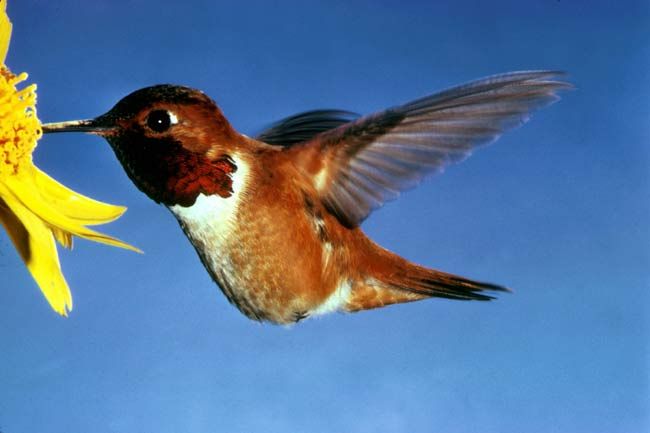High-Altitude Hummingbirds Have Bigger Wings

High-flying hummingbirds have bigger wings than lowlanders, a new study found, but when it comes to evasive and aggressive maneuvering, bigger is not always better.
To compensate for the thinner air at higher elevations, researchers found that the tiny birds evolved bigger wings than their low-elevation brethren. The increased size of the wing also results in a wing stroke that moves through a greater range of motion. The effect is that the birds have less power to fly quickly through the air.
"Larger wings and sweep angles means less excess power beyond hovering," said Douglas Altshuler, a postdoctoral fellow at Caltech. "The excess power they can produce steadily decreases as elevation increases."
The excess power to which Altshuler refers is the power available to a hummingbird when it is not hovering, but moving through the air. Larger wings are necessary for the environment at high elevations, but they are also more unwieldy and require more energy to sustain. When a hummingbird wants to move, smaller wings are an advantage.
Scientists also found that the quantity of surplus power, which is what gives the tiny avian the ability to evade predators and maintain territorial control, becomes such a valuable commodity that it is the main predictor of which hummers dominate on high.
"The birds that are dominant at high elevations are the ones with the most excess power," Altshuler told LiveScience. "At low elevations it is just a suite of important characteristics."
Researchers hoped to resolve why more hummingbirds do not live at higher elevations where there are fewer predators and seemingly less competition. At first glance, sacrificing power would appear to be a reasonable explanation, but the field studies in Peru revealed that everything is not always as it seems.
Sign up for the Live Science daily newsletter now
Get the world’s most fascinating discoveries delivered straight to your inbox.
"It turns out that if you account for the relative area available - meaning there is more area where the birds can live at lower elevations than at higher - diversity is rather flat at all elevations," explained Altshuler.
The two-year study is detailed in the Dec. 13 issue of the Proceedings of the National Academy of Sciences. Researchers netted humming birds between elevations of 1,300 feet (400 meters) and 14,100 feet (4,300 meters) in a field area that ranged from the Amazon lowlands to the mountains near Cuzco, Peru. From those 1,000 birds researchers observed 43 species that ranged in weight from 1/10 to 8/10 of an ounce (3 to 26 grams).
Scientists think the variety simply reflects adaptation to their environment.
"Think about the first hummingbird that crept up in elevation because there was no competition," Altshuler said. "Then another moves up in elevation that is bigger and can dominate the first. One might evolve to rely on size and dominance, and the other might move towards the extreme of becoming smaller and a sneaker to outwit the larger bird. A lot of it is just about evolution and filling a niche."












